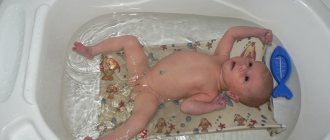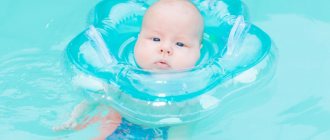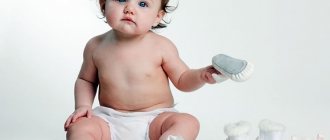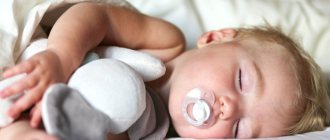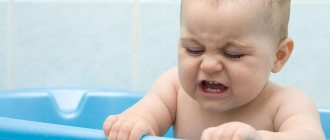A long-time participant in the Motherhood forum, a pediatrician, gastroenterologist and mother of two children (Nikita, seven years old, and Alicia, three and a half months old), talks about the amazing experience that she practiced with her eldest son during infancy, and continues to use with her youngest child.
We are talking about bathing together . After conducting a small survey among fellow doctors and friends, I was surprised to learn that the majority consider bathing together either harmful (unhygienic) or a useless pastime. And I thought that everyone practices it!
Bathing mother and baby together can be considered a variation of the kangaroo method. Let me remind you that the kangaroo method is a way of nursing babies. It is based on prolonged skin-to-skin contact when the baby is placed on the chest of mom or dad. More broadly, this technique is considered as the mother and baby staying together as often and for as long as possible, under different activities and under different conditions, including long-term free breastfeeding and babywearing. Such children develop better, are stress-resistant and less susceptible to diseases. The famous and eminent American pediatrician, Dr. Sears, writes in his books about the benefits of joint bathing.
start bathing together quite early, immediately after the umbilical wound has healed.
Procedures necessary after swimming
A small child is not wiped, only his skin is blotted with a soft towel or diaper with a sewn corner for the head.
Then they place the baby on the changing table and examine the body to identify rashes and diaper rash. After bathing, the umbilical wound is treated. Normally, it heals within 2 weeks, but requires daily attention. To reduce the risk of infection, the baby is first bathed in boiled water or a weak solution of potassium permanganate.
The skin of a healthy child does not require the use of creams, oils and other products. In case of problems, Dr. Komarovsky advises: “Wet - dry, dry - moisturize!”
Pediatricians recommend treating dry areas with baby oil, and combating redness in the folds with powder or talcum powder. Baby cream is used to treat wrinkles on the body and prevent diaper rash. A cream or spray containing panthenol is necessary for healing diaper rash and dry skin. Baby powder and talcum powder reduce moisture in problem areas.
Milk or lotion is good for preventing dry skin and does an excellent job of flaking the skin on the palms and soles.
Note! Any care products are applied to dry skin. Wipe your ears before getting dressed
The cap is put on first, then the diaper. Only after this is the baby dressed or swaddled. Some experts recommend swaddling your baby for good sleep
Before dressing, wipe the ears. The cap is put on first, then the diaper. Only after this is the baby dressed or swaddled. Some experts recommend swaddling your baby for good sleep.
After properly performed water procedures, the baby is in a good mood, ready for feeding and early sleep. Bathing is a mandatory procedure for a newborn baby, necessary for its full growth and development. It does not require special medical knowledge and skills from an adult.
Why swimming is good for babies
From birth, children are already able to swim: they can hold their breath under water and splash with pleasure in the bathtub. This is explained by innate reflexes - before birth, the baby in the mother’s stomach was in a liquid environment. Around three to four months, this innate reaction fades away, and the baby will have to learn to stay afloat much later.
However, the point of such activities with a newborn is not to make him a future Olympic champion. Increasingly, pediatricians are saying that infant swimming brings invaluable benefits.
- Regular water procedures teach children to be calm about temperature changes. Thanks to hardening, the immune system is strengthened, which reduces the likelihood of colds, promotes dynamic physical development and helps prevent a variety of health problems.
- The result of systematic exercise is the formation of correct, beautiful posture, a strong muscle corset for the children's spine.
- Water exercises are much more effective for improving the motor system than massage and stroking. They strengthen or, conversely, relax the muscles of the back, arms, legs and neck. By the way, young swimmers begin to crawl, stand up and walk earlier (which a child of 1 year can do).
- During bathing, when the child has a little difficulty breathing and the body lacks oxygen, the child’s body additionally releases red blood cells (erythrocytes), which contributes to an increase in hemoglobin levels.
- Swimming and diving have a positive effect on the lungs and cardiovascular system, help stimulate blood supply to organs and normalize blood pressure.
- When a child dives, the flowing water clears the maxillary sinuses. And this is the prevention of a runny nose in a newborn. The baby's nose is also washed, all bacteria, dust particles and possible allergens are removed.
- In water, the child calms down and gets rid of fears. Also, water procedures strengthen the bond between mother and baby, devoting time to the baby while swimming, you can better understand his body language and gestures, which will allow you to quickly find mutual understanding with your baby.
- A child taught to swim from birth will not be afraid of open water.
Another undoubted plus is that many children, after swimming and diving, quickly fall asleep and do not disturb the young mother almost all night
Which, you see, is important!
Rules for swimming with a baby
Teaching a newborn to swim will not be difficult for parents if you follow the basic recommendations.
Optimal age
Training should begin at three to four weeks. Firstly, by this time the umbilical wound is healing. Secondly, the child gains weight and gradually adapts to the new reality. Finally, infant reflexes (swimming and breathing) have not yet faded.
Preparing the bath
All procedures should be carried out in a familiar environment for the baby. Before immersion, wash the bathtub with regular laundry soap, and once a week rinse it with soda, remembering to rinse thoroughly. Be careful with potassium permanganate solution and herbal decoctions - the child may swallow the liquid. After gaining basic swimming skills, you can move on to more advanced lessons - in the pool.
Water temperature
Perform your first workouts at an average temperature of 35 °C. It can be reduced little by little, but remember - small children under three months should not swim in water whose temperature is below 32 °C. To create ideal conditions, monitor children's behavior:
- if the baby cries when immersed for several minutes, the water is too cold for him;
- if he first whines, and then falls silent and actively flounders with his arms and legs, you have selected the optimal temperature;
- if he is too relaxed and passive, the bath is too warm.
DETAILS: Optimal water temperature for bathing a newborn baby
While swimming, the water gradually cools down, but do not rush to bring it to its original temperature. This is the meaning of the procedure - the babies are hardened.
Important nuances of the procedure
Now we can move on to consider the key points and common questions regarding the bathing procedure.
When?
This question has already been partly answered above - you can bathe your child immediately after discharge from the hospital, if there are no contraindications, such as colds or a general serious condition.
The only condition is to monitor the healing process of the umbilical wound, and also, to protect against infections, boil and disinfect the water.
If you are afraid to bathe your baby until his navel has healed, then be sure to carry out all the necessary hygiene procedures and thoroughly clean the skin with wet wipes or a sponge soaked in water, avoiding the navel area. When the wound is completely healed, you can safely swim without using boiled water or disinfecting it using various means.
However, you should always monitor the purity of the water. If you are not sure about this issue, then it is better to install an additional cleaning system or filters.
How much and how often?
A newborn baby does not need a process that takes too long - it will only tire him and frustrate him. As a result, instead of calming down, you will get irritability and anxiety. In addition, such a baby will not be able to play in the bathroom with toys or soap bubbles, or play with some water.
For the first time, you can limit it to five minutes. Again, every child is different. Look at his reaction - perhaps the next day you can increase the time to seven or eight minutes, and then calmly swim for ten to fifteen minutes for a week or two. By six months, when the baby begins to sit down and play with toys, bathing can take up to half an hour, but you need to make sure that the water does not get too cold.
It is recommended to bathe newborn babies daily. With age, you can reduce the procedures: after six months, bathing can be every other day, and after a year - once every two to three days.
What time?
The issue of bathing time should also be decided taking into account the characteristics of your child and the comfort of your family.
Traditionally, pediatricians recommend performing the bathing procedure in the evening - before bedtime and evening feeding. However, some children may, on the contrary, be excited by bathing. Then you will have to move it to the daytime or earlier so that the child has time to calm down and be able to fall asleep.
One baby will be great at bathing on an empty stomach, so that he can then have a tasty and satisfying meal, while another needs to eat first, and only then perform hygiene procedures, so you must establish a daily routine that will be convenient in your situation.
However, keep in mind that a too hungry child will not be able to bathe normally and will not allow you to do everything you have planned, but a baby who has eaten heavily will not feel good in the bathroom. Therefore, the best option is to feed the baby a little an hour and a half before bathing, and then after it.
Also, do not delay your evening bathing, especially if you have already had a long bath. Try to start all procedures no later than eight or nine o'clock in the evening in order to put the child to bed on time.
It is recommended to accustom your baby to a routine from the first days of life.
Dr. Komarovsky tells how best to bathe a newborn, what products to use.
When can you bathe a child in a large bathtub?
Bathing your baby is a daily procedure that is best done before evening feeding. When bathing, especially in a large bathtub, the child spends a lot of energy, which will provide better appetite and more sound sleep. But what is the best way to bathe a newborn, in a special baby bath or in a large bathtub? Advice on this matter varies, and there is no exact limit when you can bathe a child in a large bathtub:
- The first and most common landmark is the umbilical cord. It is believed that until it heals, it is worth bathing the baby using only boiled water. Of course, it is not realistic to fill a large bathroom with boiled water every evening. Complete healing of the umbilical wound ends by 14 days after birth, but for greater peace of mind, it is recommended to wait up to 1 month.
- Reaching 7 months of age, when the baby has learned to sit, allows parents to bathe the child more comfortably in a large bathtub. However, special circles for bathing newborns, caps with foam, slides and bath mats will provide comfort during the procedure and until the child reaches 7 months.
- According to other experts, it is advisable to bathe a newborn baby in a large bathtub at least from the first day. However, many parents, fearing infection, prefer to postpone bathing in a large bath for a while.
Duration of water procedures
Recommendations must be followed:
- start water procedures from 3-5 minutes;
- if the child is not nervous, he likes everything, increase the interval gradually by 1-2 minutes;
- Having brought it up to 15 minutes, observe the baby’s behavior: if there are signs that he is comfortable, you can gradually add minutes (about 20).
The completion of the baby's bathing in the bath should take place without whims and crying. Usually by three months from birth, water treatments become a favorite pastime. If parents begin hardening activities, then bathing should be done daily, the procedure time is increased to 30 minutes. During this interval, the baby will have time to play, move his legs and arms, and roll over onto his tummy with the help of adults.
Fear of bodies of water
In addition to bathing, hydrophobia can occur in a pool or when trying to swim in a large body of water. In such cases, there is no need to put pressure on the child and forcefully drag him into the water. Moreover, you cannot laugh at his fears and show that they are not taken seriously. It is best to give him time to get used to it himself, showing by example what a pleasure it is. You can wet the baby’s feet, splash water on him while playing, or water him from a watering can. Most likely, after a while the baby will get used to it and, looking at the adults and children splashing happily, will go into the water.
If parents are faced with the fact that their child has become afraid of water, they should make efforts to help him cope with this. Feeling the calm confidence of the parents, it will be easier for the baby to feel protected and overcome his fears. views
How do doctors feel about partner childbirth?
Most experts are confident that the support of a loved one in the first stages of labor has a beneficial effect on the condition of the mother in labor. As for the process of childbirth itself, expert opinions differ.
Sergey cites statistics: 30-35% of men present at childbirth develop psychological impotence. At the same time, a man himself can express a desire to cut the umbilical cord, watch the birth of a child, record the process on video and be delighted with everything that happens.
However, this does not mean that men do not need to be present during childbirth.
The support of a loved one is very important for a woman in labor. It has been proven that a woman under stress perceives her husband’s commands better than the doctor’s instructions.
The spouse does not need to see intimate details. However, he can help in terms of organizing the process: conveying the obstetrician’s words to the wife, keeping her informed of events, monitoring instrument readings.
Obstetrician-gynecologist Ekaterina Khersonskaya believes:
There is a stereotype that men faint or behave inappropriately during the birth of their wife. As a result, doctors are distracted by trying to bring dad back to his senses and forget about the woman in labor herself. In fact, such cases are rare.
What is partner birth? General information about joint childbirth
Pros and cons of bathing with your baby
Bathing in the bath with mom brings a lot of useful emotions for the child. If there is a loved one next to the baby, he:
- less afraid of water (read also: What to do if a child is afraid to swim in the bathroom);
- feels safe;
- satisfied with water procedures;
- calm, because Mom is nearby.
Swimming with one of the parents will bring pleasure to the child and help him fall in love with water procedures.
There are practically no downsides to swimming together. The only thing is that parents need to thoroughly clean the bathtub every day before bathing the baby. But if everyone in the family is accustomed to maintaining hygiene, then such treatment will not lead to additional difficulties.
Bathing rules
There is nothing wrong with swimming together, but hygiene and special rules must be observed:
- Before taking a bath with the baby, the parent must wash himself.
- If mom or dad suffers from a fungal or skin disease, joint water procedures with a small child are prohibited.
- You cannot swim with your baby if the adult is not feeling well. He may lose consciousness and drop the baby.
- The optimal temperature for bathing a baby is 37 degrees (read also: Optimal water temperature for bathing a newborn baby).
- You need to dip your baby into the water slowly so as not to scare him.
- You should not leave the bath with your baby in your arms, as you risk dropping him. It is best to give the baby to another adult while in the water, and then go out yourself.
- Doctors do not recommend bathing a child with an unhealed umbilical wound.
The child is not inclined to swim in large amounts of water without support. This creates fear in him and leads to a breakdown in contact between mother and child:
- anxiety, restlessness;
- poor sleep;
- breast refusal;
- Frequent, causeless crying.
All these are the consequences of stress from bathing in a large bath, diving, or using early swimming techniques. Some parents let their child go into a large bath with a circle around his neck. But the circle will not relieve the baby from the fear of being alone in an unfamiliar, frightening space. In addition, such support leads to clamps in the cervical region, which causes pain in the baby.
Preparation for water procedures
Preparing for bathing a baby should be approached with the utmost seriousness, so as not to harm the little person through inept actions. Before water procedures you should:
- wash the bath well;
- Place a special non-slip mat on the bottom;
- check the water - it should be about 37 degrees;
- so that the water temperature does not change, it can be left flowing from the tap;
- the bath should not be filled more than halfway;
- add herbal infusions if desired;
- prepare diapers, towels and clean clothes for the baby;
- Comfortable air temperature for the bathroom is 22-25 degrees.
Bathing process
It is very important when bathing with your baby in a large bathtub to do everything correctly so that the child does not develop a fear of water.
Children under three months of age are frightened by large volumes of water, so the baby should be immersed very carefully, holding it in an upright position.
- First, the baby’s legs are immersed in water, then the baby is placed on his back;
- the mother should remain calm during the bathing process, as her mood is largely transmitted to the baby. Sensing the anxiety of a loved one, the child will begin to get nervous and cry. At first, it is advisable to bathe the baby together;
- If the baby is fussy in the water, you can give him breastfeeding. Talk to him in a calm and gentle voice. He must feel his mother's presence all the time;
- you need to remove any negative factors that may upset or frighten the baby. Make sure that the water does not get into the baby’s nose and mouth and that it is at the recommended temperature, that is, 37 degrees;
- You should position yourself in the bath so that it is comfortable for both: mother and baby. It is best to place the baby in the corner between the mother’s stomach and legs. The baby's tummy and legs are covered with water;
- Bathing time should not exceed 15-20 minutes.
When your baby learns to sit, he will happily splash around with you.
Tips for parents
Tips for parents for a successful bathing process:
- If your baby is very nervous before bathing, postpone or reschedule the procedure. Since there is no particular need for enhanced body hygiene at first, bathing should be enjoyable.
- After some time, invite the baby to “join” bathing again. The baby must be in a good mood.
- If the child does not agree to be alone in a large bathtub, try bathing together.
- If the baby liked to bathe in a small bath, then a large one will probably work just as well. Maintain emotional contact and entertain your baby while swimming in an unusual environment.
- Try to make bathing a familiar, regular ritual.
Evening water procedures are useful for children, as they allow you to tire the baby before bedtime and stimulate an appetite. This is a great way to ensure a good night's sleep for the whole family.
Causes of fear of water in a newborn
Know! Before the age of one year, there is no need to bathe your baby with soap or use shampoo frequently. It’s better to add a little brewed string or chamomile to the water.
If a newborn is afraid to swim in water, this should alert parents. After all, he spent his first minutes of life in amniotic fluid, in his mother’s tummy. Ideally, the first meeting with water should be favorable for the baby.
Why might he begin to be afraid? Until about six months, babies do not experience strong feelings. During this period of life, children only need to fulfill their basic physiological needs: nutrition, breathing, sleep, toileting. Therefore, if a child is afraid to swim, most likely this is not a manifestation of fear, but discomfort when in contact with water.
For example, a child may not like:
- when the water is too hot or too cold;
- contact with water during rapid immersion of the body;
- slippery bath bottom;
- when there is too much water, or the bath is too large; Find out from the article how to choose a bath for a newborn?>>>
- disturbing itching or rashes on the body (upon contact with water, the skin in the area of irritation begins to sting);
- nervous behavior of an adult.
In the case of a newborn, it is not difficult to solve the problem of emerging hostility to the process of taking a bath; just bathe the child correctly the next time and he will no longer be afraid to bathe. Read how to bathe a newborn baby for the first time at home?>>>
For a comfortable bathing you need to take into account several rules:
- Before swimming, test the water with the back of your hand or elbow. Or stick to a temperature of 36-37 degrees Celsius;
- A baby's bath requires very little water. Keep in mind that when the child’s body is immersed, the water will rise higher;
- It’s good if mom puts on some nice music before bathing. Children remember sounds well and get used to swimming to a certain melody;
- Wrap the baby in a small, thin diaper and bring it to the bath;
- First, you need to introduce your feet to water. Dip your feet into the water and let your baby move them and get used to it;
- Gradually lower the baby lower, from time to time rolling a little water on him with your palm. The main thing is to continue to hold your head on your hand;
- It’s good if the mother has an assistant who will wrap the baby in a towel after water;
- Even if the child was a little naughty, it’s okay. Feed the baby and let him rest.
general information
To prepare such baths, concentrates from pine needles, cones and coniferous tree bark are used. Most often on pharmacy shelves you can find extracts from fir, pine, cedar, spruce and juniper. The list of types of pine extracts is quite large: dry briquettes, liquid solution, in the form of tablets or powder, sea salt impregnated with concentrate. And if you are not too lazy, you can prepare a useful solution yourself.
The needles are rich in useful elements, namely:
- Vitamins of group B, C, E, P, PP, K.
- Microelements.
- Essential oils.
- Antioxidants.
- Carotene.
- Tannins.
- Phytoncides.
Despite the great benefits of pine baths, only a doctor who knows the child’s condition should prescribe them to infants. Pine baths are prescribed for children over six months of age. But if the child was born weak or, then such baths are prescribed earlier, as soon as the baby gets stronger.
Preparing for a swim
Before you start swimming, you need to prepare all the necessary attributes.
- The bathing area must meet several requirements. Firstly, the temperature in the room should be about 22–24 degrees, without drafts. Secondly, it should be possible to approach the bath with the baby from all sides.
- Bath. As a rule, babies buy a special baby bath for bathing. But if you wish, you can bathe your child in a regular bath, but before use it must be washed with a special product and doused with boiling water to disinfect. For preventative purposes, you should also treat the baby’s bath before each bath.
- The next important point is water. Previously, it was believed that bathing a newborn could only be done in boiled water. Experts are now confident that using regular running water will not harm the baby. The issue of using a solution of potassium permanganate to disinfect the umbilical wound during bathing is being actively discussed. One group of pediatricians is confident that you can bathe your baby on the first day after leaving the hospital, but it is necessary to add potassium permanganate. Another group is sure that bathing is possible only after the wound has completely healed, on days 18–22. In this case, the decision remains with the parents. But in order to make the most correct choice, it is worth consulting with your local pediatrician.
- As for the water temperature, it should not exceed 37 degrees; ideally, its range should be from 34 to 37 degrees. You should measure the temperature with a special thermometer in a plastic case without removing it from the water. After a few days, you can lower the starting temperature, gradually bringing it to 32 degrees.
- Special soap or shampoo. It is recommended to use baby soap, as it does not contain fragrances and, as a rule, does not cause allergic reactions in babies. You should use soap no more than once a week in winter, and 2-3 times in summer.
- Baby washcloth. To bathe your baby, you can use a piece of soft cloth, special soft baby washcloths as a washcloth, or simply wash your baby by hand. Since a newborn's skin is very delicate, do not press too hard on the washcloth. It is necessary to run your hand over the baby's skin with neat, gentle movements, creating a massage effect.
- Herbal infusions. Herbal infusions have anti-inflammatory, soothing, antiallergic properties. Have a beneficial effect on the skin of a newborn.
Before using herbal infusions, you should consult your pediatrician about their need. If the doctor gives his consent, then it is worth clarifying the rules for preparing the infusion so that the excessive concentration of herbs does not have an unnecessary effect.
It is also worth preparing a ladle of clean water to rinse the baby. It is worth unwrapping clean diapers in advance (usually one thin, the other thicker) or a soft towel with which you will dry the baby. You can also prepare clothes for the baby, which he will wear immediately after bathing and skin care procedures. Usually this is a vest, a hat and a diaper or rompers.
What to do if a child does not like to wash and screams?
Such situations do occur, says Komarovsky.
But the point here is not at all about the child and not even about the fact that he is afraid of something. Most likely, according to a famous pediatrician, bathing conditions should be adjusted. Maybe the water temperature does not suit the baby - it is too high or too low for him. After experimenting for several days, parents will be able to understand which water is most comfortable for their child. Bathing should begin with it - and only then adjust the temperature in favor of cooling (adding cold water in a thin stream) or heating (adding hot water in the same way).
For example, a mother tries to bathe her baby only at night, and it is at this time that the child wants to sleep and not bathe. Therefore, Komarovsky gives some advice that will help parents whose children have trouble in the water:
Change the time of day.
Change your eating and bathing routine. If your baby screams when bathing half an hour after eating, then try bathing him half an hour before eating (or vice versa).
Practice sharing baths with your baby.
What does the process consist of?
Water treatments
- Undress the baby.
- Place the baby with its back on the forearm of your right hand.
- Lower the baby into the bath, supporting the body under the shoulder blades and placing the head on the forearm.
- During the bathing process, gently and calmly communicate with the baby.
- With your free hand, pour some water over your chest and rinse your neck.
- Do not splash your face or pour water, so as not to scare the baby.
- Gently wet your hair, lightly massaging the head.
- Carefully rinse all folds where water does not naturally reach.
- After 7-8 minutes, finish bathing.
- Move your hand deeper under the body and remove the baby from the bath.
- Wrap the baby in a towel.
- Dry your face with a small napkin or towel.
- Move to the room for hygienic treatment.
Hygienic treatment of the child
What does child hygiene treatment include:
- Place your baby on the changing table.
- Dry your body with a towel. Do not rub or press to remove moisture more thoroughly.
- Turn the baby around and keep him undressed for a few minutes to allow the skin to dry and breathe.
- Remove moisture from all folds and folds.
- Wash your face with damp cotton pads.
- Wipe your eyes with moistened cotton pads towards your nose. Use a separate disc for each eye.
- Remove moisture from the nose and ears with cotton swabs: twist a thick flagellum from a piece of cotton wool and insert it into the ear or nasal passage (shallow). The cotton wool will absorb moisture.
- If necessary, cut your fingernails and toenails.
- Examine the condition of the skin. If the skin is smooth, intact and not inflamed, do not apply anything additional. If you find dry or flaky areas, treat topically with baby cream or oil. If the folds turn red and retain moisture, lightly spray the dried surfaces with powder.
- Put a diaper on your baby.
- Dress your baby for bed.
- Start feeding.
We invite you to watch a video about what hygiene procedures need to be carried out after bathing:
Choosing the right place to relax by the water with a small child
It is worth paying more attention to the existing and specified rules of conduct located directly next to each of the reservoirs. That is why you should only visit prepared places for relaxation with your child, without allowing him to move too far away from you. This will give you and your baby the opportunity to safely relax while enjoying the sun by the water.
There should be lifeguards in swimming areas. You can’t leave your child alone; friends will help in case of danger.
Children may experience fear and shock, and they will resist with all their might so as not to drown, and they may not allow you to be pulled to shore. This is why every parent should think twice when going to a lake where there is no prepared beach and no professional lifeguards with a boat.
Rules of caution
It is even more worth considering the character and behavior of your children if it is a fast-flowing river or a sea beach. Parents should always be near the water, ready to help if there are no rescuers or a special service that can help with emergency assistance. Also, it is worth taking into account your own strength in the water. The ability to swim well does not mean that you can save a child, especially if he has already reached 12-15 years of age. This may require more serious help, even the participation of several people.
In addition to knowing the rules, children must clearly remember the prohibitions
During rest, parents should be located closer to the water, and not at a distance, in order to react in a timely manner and come to the rescue if necessary. It is advisable that your child is not left alone in the water for even a minute.
Opportunities for help will become more relevant if several teenagers swim and play in the water together, who can always help out and help each other.
The best opportunities for relaxation by the water: a choice of a wild or public beach
If you want to reduce risks, and even more so if you have a very small child, choose specially prepared beaches for family vacations and swimming. This will allow you to ask for help at any time from rescuers with the special equipment and equipment available. But if you know how to swim on your own, and your child also takes part in swimming in a sports section, then you can choose a wild beach near the water. But even here you should not neglect safety requirements.
Study these rules with your child and have a safe rest.
At the same time, it is important for everyone to always make it a rule that you should not leave your children alone for a second. Only by being in the water together can you protect your family from accidents.
Using elements such as life jackets or inflatable mattresses while swimming will allow you not to worry about your child, that he may end up completely under water. In this way, you can show your concern and teach children proper behavior on the water in the future.
